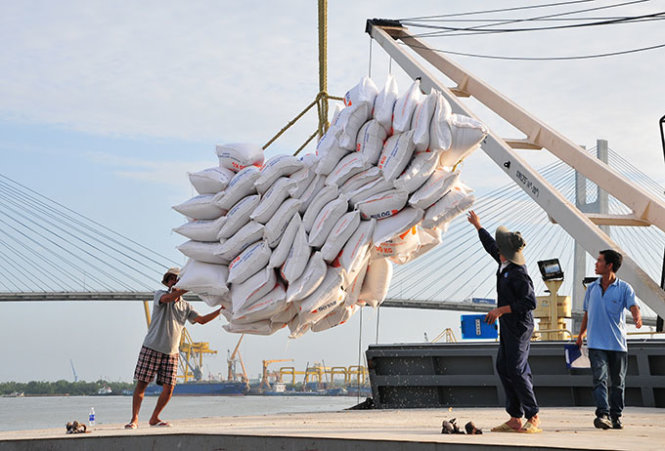Agri-export businesses post increase despite disastrous year
 |
Nguyen Vu Loc, chief executive officer of Westfood Company in the Mekong Delta city of Can Tho, told VIR that his firm’s seven-month export turnover increased by over 100 per cent.
“Our growth rate is expected to climb 40 per cent this year,” he said. “We will continue expanding our exports to the US and the European Union, from over 20 nations now.”
Westfood’s success has contributed to the agro-forestry-fishery sector’s laudable export achievements in this year’s first seven months.
Last week, the Ministry of Agriculture and Rural Development (MARD) reported that during this period the sector hit a total export turnover of $17.8 billion, up 5.1 per cent against the same period last year, when it reached $16.9 billion, down 3.6 per cent year-on-year.
In this period, Vietnam-based firms exported 1.13 million tonnes of coffee, making a turnover of almost $2 billion, up 38 per cent in quantity and 18 per cent in value year-on-year.
According to a source from Thu Ha Coffee Company, a renowned domestic brand, the firm’s coffee export turnover has climbed significantly since the beginning of this year and might be in the double digits for the whole year.
Meanwhile, the wood export sector has also shown big achievements.
Nguyen Ton Quyen, chairman of the Timber and Forest Product Association of Vietnam, told VIR that Vietnam-based wood firms earned an export turnover of $4 billion in this year’s first seven months, up 7 per cent year-on-year. Of this, 42 per cent was earned by foreign enterprises.
It is expected that the figure would reach $7.4 billion for the year, up 10 per cent on-year.
Many firms are performing very well at exports, such as Nam Dinh Export Foodstuff and Agricultural Products Processing, and Woodland in the north, and Tien Dat, Binh Dinh Wood, and Dai Thanh in the south.
Nam Dinh’s wood export turnover is expected to rise from $32 million last year to $37 million this year, while Woodland’s will increase to $35 million from $30 million last year.
“On average, all these firms’ export turnover will rise by 5-10 per cent this year. Demand for Vietnamese wooden products is surging, especially in the US, Japan, and South Korea, which are Vietnam’s key export markets,” Quyen said.
The MARD has also reported that Vietnam raked in $3.65 billion from exporting aquatic products, up 3.3 per cent against the $3.5 billion (down 17 per cent year-on-year) of last year.
For instance, Hung Vuong Seafood Company last week reported that between October 1, 2015 and June 30, 2016, the firm celebrated a significant rise in export turnover, from $150.7 to $213.45 million.
According to the MARD, the agro-forestry-fishery sector’s export turnover should have been far higher than the $17.8 billion, had the sector not been hit by droughts and saline inundation, and the environmental scandal caused by Taiwanese firm Formosa in the central region.
During this year’s first seven months, as a result of these calamities, over 400,000 hectares of crops have been affected with varying degrees of output loss, and 25,900 hectares remained unplanted.
Meanwhile, the Formosa scandal has been directly affecting the livelihood of nearly 300,000 fishermen since April. Fishermen have suffered from a loss of 1,600 tonnes of fish every month.
New agro minister vows to tackle food safety first In a recent interview shortly after being appointed, new Minister of Agriculture and Rural Development Nguyen Xuan Cuong identified three challenges to Vietnam’s agricultural development in the time to come. First, Vietnamese agricultural production is very fragmented, with households cultivating an average of 0.3 hectares each. According to Cuong, this is a barrier to large scale, efficient, and sustainable farming. Second, the effects of climate change are rapidly intensifying, and Vietnam is among the most badly hit countries. In the first six months of 2016, Vietnam has seen this all too clearly and all regions suffered, especially the Mekong Delta area, the Central Highlands, the south central region, and the northern mountainous region. Climate change is going to alter the patterns of production and people’s lives. Third, Vietnamese agricultural products are exported to 180 countries. With deeper economic integration, there will be more opportunities to expand the market, but there is also high pressure to increase quality and safety standards. Regarding his plan of action during this term, he said first he was going to focus on food safety. Besides, the ministry plans to overcome the above three challenges by restructuring agricultural production in Vietnam, linking stakeholders in the field, namely farmers, input producers (e.g. seeds and pesticides vendors), and companies that use or distribute produce, creating stronger co-operation to make agriculture more efficient and sustainable. Another area of focus would be to shorten the gap between rural and urban areas. He said 78 per cent of rural communes are very poor, with the most extreme levels of poverty to be found in remote, mountainous areas. To address this, the new minister will work on inviting investment into developing agriculture in these areas, as well as improving lives there in order to shorten this gap. |
What the stars mean:
★ Poor ★ ★ Promising ★★★ Good ★★★★ Very good ★★★★★ Exceptional
Latest News
More News
- Ministry proposes tripartite coordination mechanism to manage cryptocurrency exchanges (March 25, 2025 | 15:06)
- Singaporean PM’s visit to Vietnam to strengthen comprehensive strategic partnership (March 25, 2025 | 14:40)
- New tax policies aim to bolster tech sector (March 24, 2025 | 15:20)
- Japan's Tokyu Group proposes light rail transit in Binh Duong (March 24, 2025 | 14:52)
- Ministry pledges funding for science and technology development (March 24, 2025 | 14:44)
- Chinese carmaker Geely moves into Vietnamese market (March 23, 2025 | 09:00)
- Ministry of Finance and World Bank discuss new ODA-funded projects (March 21, 2025 | 18:11)
- Bank of China offers support for Vietnam to build international financial centres (March 21, 2025 | 14:23)
- Hungary to train 1,000 Vietnamese specialists for country's first nuclear plant (March 21, 2025 | 08:46)
- Securities firms raise capital in anticipation of market upgrade (March 20, 2025 | 13:35)


















 Mobile Version
Mobile Version